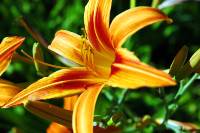Navigation boxes
This section is used to demonstrate how the content relation engine can be utilized in oder to create a kind of additional local navigation based on categories.
All the contents are assigned to a single category and at each page, there is a list box displayed linking to all other contents of the same category.
Lilaceous Plants
Recent news
Cooking with flowers
Jan 5, 2009

New edition will be released in 2009. More than 100 new recipes and lots of useful tips for planting.
Jekka McVicar, expert herb grower and best-selling author, examines 50 flowers, with tips on how to grow them in your garden, or in containers, and when to harvest. Showing which parts of the flowers are the tastiest and which should be removed, Jekka provides at least 2 recipes for each flower.
Transportationbag for Christmastrees
Dec 10, 2008

Since this season, carrying bags for christmas trees are available.
The advantage of these bags is clear. Well stored trees cannot soil cars, clothes and houses. But this bag is also useful for a needle-free removement of the tree. The manufacturer offers also the possibility to print advertisements on the bags- this can ba a good campaign for the christmastree vendors.
Lily
The genus Lilium are herbaceous flowering plants normally growing from bulbs. They comprise a genus of about 110 species in the lily family, Liliaceae. They are important as large showy flowering garden plants.
Lilies are leafy stemmed herbs. They form naked or tunic-less scaly underground bulbs from which they overwinter. In some North American species the base of the bulb develops into rhizomes, on which numerous small bulbs are found. Some species develop stolons. A few species form near the soil surface.
Many species form stem-roots. With these, the bulb grows naturally at some depth in the soil, and each year the new stem puts out adventitious roots above the bulb as it emerges from the soil. These roots are in addition to the basal roots that develop at the base of the bulb.
Most species are deciduous, but a few species (Lilium candidum, Lilium catesbaei) bear a basal rosette of leaves during dormancy.
Seeds ripen in late summer. They exhibit varying and sometimes complex germination patterns, many adapted to cool temperate climates.
The large flowers have six tepals, are often fragrant, and come in a range of colours ranging through whites, yellows, oranges, pinks, reds and purples. Markings include spots, brush strokes and picotees. The plants are summer flowering.
Some species formerly included within this genus have now been placed in other genera. These include Cardiocrinum, Notholirion, Nomocharis and some Fritillaria.
This article uses material from the Wikipedia article Lilium and is licensed under the GNU Free Documentation License.


